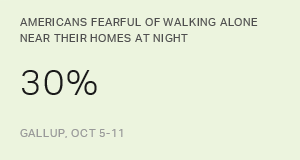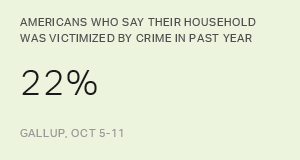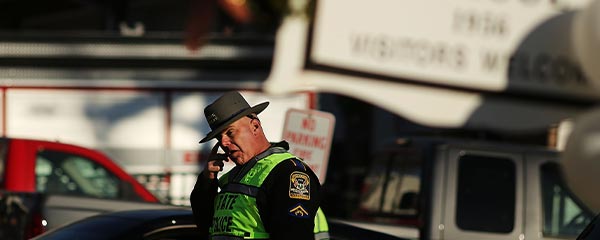Story Highlights
- 38% say there is less crime in their local area; 40% say more
- 68% say there is more crime in the U.S., unchanged since 2015
WASHINGTON, D.C. -- Americans' perceptions of crime in their local area have improved since last year. The percentage of U.S. adults saying there is less crime in their local area has risen by five percentage points; those saying there is more crime has fallen by the same amount.
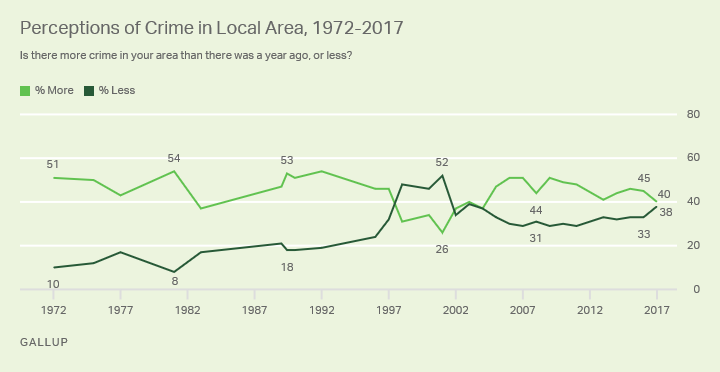
These results are based on Gallup's annual Crime poll, conducted Oct. 5-11. Since 1972, Gallup has regularly asked the public to assess crime in the area where they live. Americans were most positive one month after 9/11, when 52% said crime had decreased locally in the past year. That optimism about crime was not long-lived, however -- by 2002, Americans had returned to their historical pattern of being more negative than positive about crime in their area. The current 38% "less crime" reading is the highest since 2004 and significantly better than the first 20 years of Gallup's trend.
Consistent with past findings, women (including a majority of those younger than 50, at 52%) are most likely to say there is more crime this year in their local area. This compares with 33% of men in the same age group. Assuming that men and women generally live in the same areas across the country, these gender differences appear to reflect underlying sensitivity to the issue.
Those with an annual household income of less than $30,000 are significantly more likely than those making $75,000 or more to report an increase in crime in their area (49% vs. 35%, respectively).
Perceptions of Crime in the U.S. Remain High
A clear majority of Americans (68%) say crime is on the rise in the U.S., essentially unchanged from 70% last year. This level of pessimism is not unusual. Since Gallup began measuring public views of crime nationwide in 1989, Americans have consistently viewed it much more negatively than the situation in their own area. Each year -- except in 2000 and 2001 -- Gallup has found a majority of Americans saying there is more crime nationwide than the previous year. The highest reading of 89% came in 1992.

Among the groups most likely to say U.S. crime has increased since last year are women (76%), nonwhites (75%) and those with household incomes under $30,000 (77%). While perceptions have varied by political partisanship throughout the years, there is no difference between Republicans and Democrats this year -- 66% of each say there is more crime nationally. During Barack Obama's presidency, Republicans were more likely than Democrats to say crime was up. The opposite was true during most of George W. Bush's presidency.

Gallup Analytics
Subscribe to our online platform and access nearly a century of primary data.
U.S. Crime Nationwide: Perceptions vs. Reality
Americans' views on the state of crime do not always echo reality. Government statistics tracking crime rates lag one year, which makes it impossible to assess whether public views are consistent with actual crime rates until the following year.
There are two annual sources of crime data from the federal government -- an FBI report of crimes reported to police around the country and a Bureau of Justice Statistics survey of U.S. households asking Americans aged 12 and older if they have been a victim of a crime in the past six months. Both sets of data show a large, mostly consistent decline in violent crimes since the 1990s.
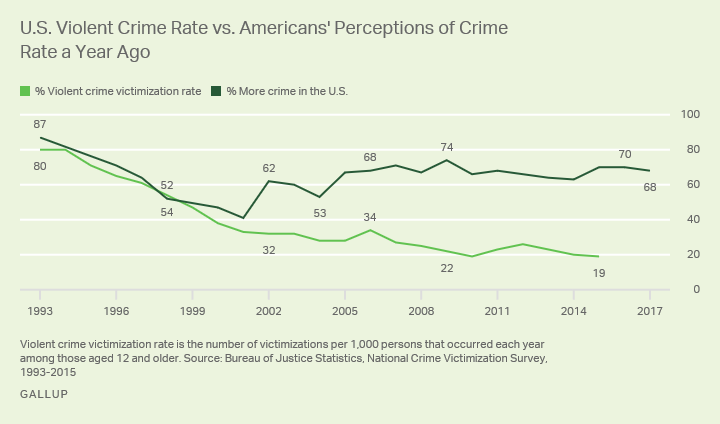
The FBI released its 2016 crime data in September, finding a 4% increase in violent crimes from 2015 to 2016 -- which was not echoed in the public's perceptions. The Justice Department has not yet released its 2016 survey data, but its report last year found no significant increase in violent crime from 2014 to 2015. Yet Gallup found an increase in the percentage of Americans who said crime was up nationally in that time period. Perceptions of crime and government statistics generally correlated as crime dropped precipitously from 1993 to 2001, but they diverged after that.
Bottom Line
Although government data showed a decrease in crime in the U.S. for most years between 1993 and 2010, majorities of Americans still said nearly every year that crime had increased nationwide. Most recently, public perceptions of local crime have grown rosier while their assessments of national crime have remained pessimistic. The latest FBI report finds that crime is on the rise nationally, while Americans' perceptions have plateaued.
Survey Methods
Results for this Gallup poll are based on telephone interviews conducted Oct. 5-11, 2017, with a random sample of 1,028 adults, aged 18 and older, living in all 50 U.S. states and the District of Columbia. For results based on the total sample of national adults, the margin of sampling error is ±4 percentage points at the 95% confidence level. All reported margins of sampling error include computed design effects for weighting.
Each sample of national adults includes a minimum quota of 70% cellphone respondents and 30% landline respondents, with additional minimum quotas by time zone within region. Landline and cellular telephone numbers are selected using random-digit-dial methods.
View survey methodology, complete question responses and trends.
Learn more about how the Gallup Poll Social Series works.

